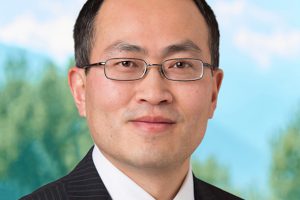
Dr. Kai Pan is an Associate Portfolio Manager on the Greater China research team. He joined Wasatch Global Investors in 2019 as a Senior Analyst focused on emerging markets.
Prior to joining Wasatch, Dr. Pan was a sell-side analyst for nine years at Morgan Stanley covering property-and-casualty insurance companies, including Berkshire Hathaway. From 2004 to 2009, he was a buy-side analyst at New York City-based Stadia Capital, a long/short equity fund that was part of FrontPoint Partners and Morgan Stanley Investment Management. Before his investment career, he spent five years in Silicon Valley at a start-up company, modeling natural-catastrophe risks.
Dr. Pan received Bachelor’s degrees in Civil and Environmental Engineering from Tsinghua University in Beijing, Master’s and PhD degrees in Structural Engineering from Johns Hopkins University in Baltimore and a Master of Business Administration from New York University Stern School of Business. Dr. Pan is an active volunteer with the Whiting School of Engineering, having served as a mentor as a part of the school’s mentoring program. He also serves on the school’s Hopkins Engineering Alumni Leadership Committee, a group of dedicated volunteer leaders that help support and guide the Whiting School’s alumni relations program.
Dr. Pan is a native of China. He met his wife Li in college, and they have two sons. He enjoys traveling and hiking.
What made you choose Johns Hopkins?
Upon graduating from Tsinghua University in Beijing, China, I was determined to pursue graduate degrees in the U.S. That was in 1993 and pre-internet. I remember that I had to go through volumes of graduate school information in the library. Johns Hopkins has a strong reputation in China. It naturally became one of my top choices.
As most Chinese students aspiring to study overseas at that time, I could not even afford the application fees, let alone the tuitions and living expenses. So I applied for scholarships and asked for application fee waivers. I was ecstatic when I received a thick envelope from the Civil Engineering Department of Whiting School awarding me the Joseph Meyerhoff Fellowship. I was very fortunate to attend a world-class institution with a full scholarship.
Do you have any memories that stand out from your time as a student?
Hopkins is a research focused institution. My four years of studying there went far beyond the classrooms. I vividly remember the experiments in the wind tunnel lab. Wind tunnel is like a ventilation duct with a huge fan blow air through. We had models of bridges and buildings in the tunnel to measure their structural responses to wind. These hands-on experiences helped me enormously to understand the abstract theories and how to apply them in the real world. One of my fellow students actually scaled the giant cables on the Golden Gate Bridge to study the vibration of these cables under windy conditions. It’s like in a Mission Impossible movie!
The small community and close relationship with your professors and fellow students was my favorite part at Hopkins. Professor Nicholas Jones was my PhD advisor. Beyond academic, he invited students to his house for barbecue each summer. I also remember those softball games and parties at PJ’s Pub.
Do you have any advice for current engineering students?
Be curious. Hopkins’s small classes offers plenty of opportunities to raise your hand and ask questions. Outside the classroom, there are many research projects you can work on to sharpen your analytical and problem-solving skills.
Keep an open mind. There are many career opportunities beyond your current field of study. I would take the full advantage of what Hopkins has to offer, from engineering, art and science, and to medicine. By exploring more, you might find your true passion.
Where are you working now? How did you get involved in this line of work?
After graduation, I joined a startup in Silicon Valley. We developed mathematical models and software to assess potential property insurance losses from natural catastrophes such as hurricanes and earthquakes. It was an exciting time during the Tech Bubble of 2000.
After five years, I became more interested in business. I went back to business school to earn a MBA degree. That helped me transition from engineering to finance. Since then, I worked at a hedge fund, including a first hand experience during the Financial Crisis of 2008. Then I spent nine years as an equity research analyst at an investment bank, covering insurance companies.
In 2019, a new opportunity presented itself. I joined an investment fund on its emerging market team. It has been exciting to learn new companies in new industries and in new countries. As Warren Buffett said, I tap dance to work every day.
You will never know what future will bring. But you can learn a little more each day and be ready when opportunity knocks on your door.
Why and how do you choose to stay connected to Johns Hopkins as an alumnus?
I am grateful for the world-class education at Hopkins and the scholarship making that dream come true. I have been actively following school development and participating in alumni events. Giving back to Hopkins is an annual ritual for me. I am volunteering in a mentoring program for undergraduate students. Recently I was invited to join the Engineering Alumni Leadership Committee. Johns Hopkins has given so much to me. I hope I can give her back by paying it forward.